LAST UPDATED: May 1st, 2015
So you just shot a buck on the fifth day of a seven day solo hunt in the backcountry, and you’re 6.5 miles from your truck. Now what? Well, unless you can find some horses running around…you’re probably going to need to get your buck broken down and start to burn some boot leather packing it out on your back. The old motto “releasing the arrow is the easy part, the real work begins after you get an animal down” couldn’t be more true. An ideal situation would be to have a friend help you take care of the meat and pack an animal out. However, sometimes you have to get creative and dig deep when doing it solo.
Before you get in this situation, you should plan ahead and before trying to tackle this task. Believe me…nothing is worse than experimenting on quartering out and/or de-boning an animal in below freezing weather conditions without the proper gear to get the job done. You want to get that animal properly broken down while taking the required steps to get all of the meat removed….all while doing it efficiently. Getting your meat ready to pack out in a timely manner, while minimizing contact with debris on the ground, will help ensure that you have tasty steaks for the dinner table.
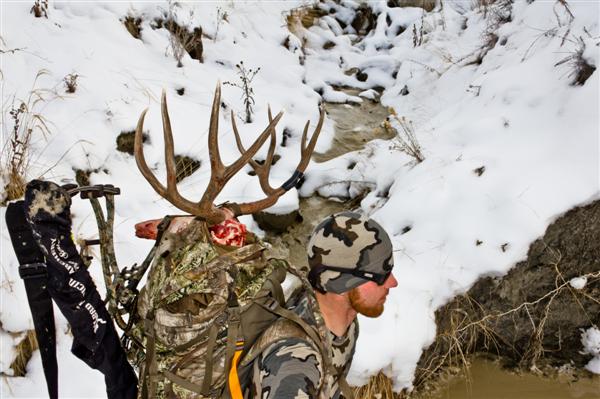
There are many advantages to packing out your bow kill. However, there are just as many pitfalls to the process if you don’t know what you’re doing.
Packing out your own animal is all about knowing your physical limitations. Don’t try to bite off too much if you are not adequately prepared to pack a large animal like a bull elk out of the mountains solo during the early part of September. We all owe it to ourselves to get the meat out as quickly as possible. When in doubt, try to contact a few friends to help you pack meat, even if it means hiking to get cell service or heading back to your truck and driving to town.
Equipment NeededGear choices for packing out an animal are sort of like gear choices for setting up a new bow. There are a lot of options for each type of person. Personally, I have found the following items make the job easier on myself and have proven to work great throughout my bowhunting career. When it comes to knives, I prefer to carry the lightest knife for preparing my trophy in the field since I will be carrying this knife each day. You do not want to carry a heavy saw or giant knife in your pack if you don’t need to; just like all of your backpacking gear, you want it to be as light as possible yet still get the job done. The less weight you have in your pack, the harder you can hunt…the harder you hunt…the more successful you can be. (shop for backpacks)
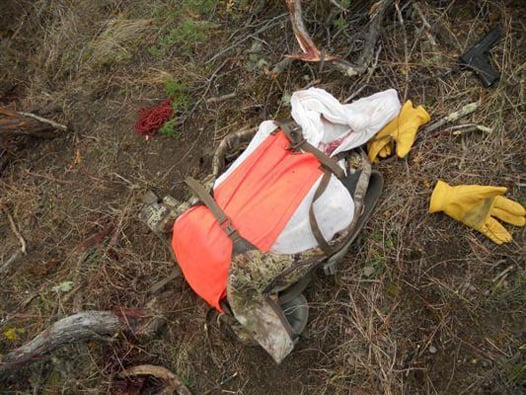
The right game bag can make hauling your meat easier, as well as keep it cool, while also keeping your backpack clean of blood and odor.
I’ll be the first to admit…I don’t like carrying the extra weight of game bags in my backpack each day I hunt. But, I am hunting and therefore expecting to kill something, and even though I love the experience of the hunt, I am not just taking my bow out for a walk. It is for this reason that I pack game bags each day I am hunting, no matter if it’s a daytrip for antelope, a weeklong hunt for elk where I am moving camp each night, or a weekend mule deer hunt where I am headed back to the same tent location each night. Game bags prevent your hard earned meat from getting contaminated from a variety of sources such as dirt, sticks, and insects. I just keep thinking in my mind how miserable it would be if I didn’t have game bags with me when I make a kill. Like the old saying goes, “I’d rather have it and not need it, than need it and not have it.” It’s also a great idea to pack garbage bags if hunting during the hot early season, to give you more options for preventing your meat from spoiling. Placing your meat in garbage bags and then placing them in a stream will ensure they stay cool while you pack the rest of your meat.
Game BagsI have used a lot of different brands and materials of game bags over the years, and I think I have finally found the perfect system for my style of hunting. Cotton has fairly decent breathability, but it doesn’t hold blood well, is difficult to reuse after washing due to staining and odor retention, and it tears easily. Canvas game bags are too heavy for most situations where you are backpacking them in. These would be a great option if you’re hunting from a horse. I prefer a light-weight, breathable, synthetic game bag, as it seems to solve these problems. I rarely get blood on the inside of my pack, they don’t retain odors after washing, and they are extremely lightweight. One thing to look at with synthetic game bags is breathability- make sure if you’re hunting a long distance from your vehicle that your game bags allow your meat to cool. The worst thing would be a game bag that keeps the heat in. Those types of bags might be the lightest weight, but they sacrifice the most important reason for a game bag in my opinion. Not having breathability will potentially spoil your hard earned meat.
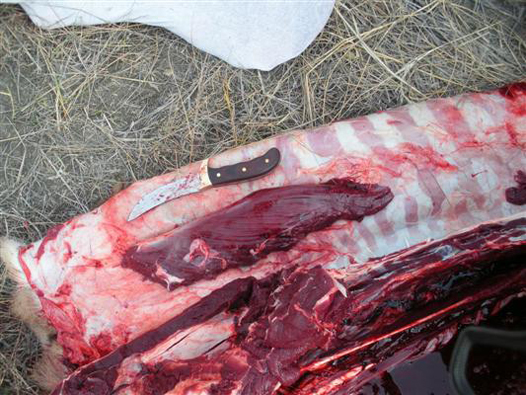
A good knife it vital to “post-shot” success. The right one will be lightweight and sharp as a razor.
Cut It And Cool ItA person can quarter or de-bone an entire animal with just one knife and without using a heavy saw. I prefer to use a lightweight knife that has replaceable surgical blades. In total my knife and extra blades weigh just a few ounces. This system eliminates having to carry the weight of a sharpening stone each day. I do carry a small multi-tool that works perfectly for cutting branches out of the way before you start to break down your animal. For example, this past fall (2012) my mule deer buck lodged into some trees and pinned his rack in some branches when he collapsed. Having a small multi-tool saved me some heavy lifting as I was able to cut the branches away freeing my buck to slide down the steep slope to a small flat bench where I could work break him down. (backpack videos)
One important part about packing out your own game is how you will store your meat once you get back to your truck. For this reason I always bring along a cooler that I will place my first load of meat into while I make multiple trips for the rest of the meat. You do not want your meat sitting in the back of your truck all day, since that’s an invitation for insects and/or other animals to chew on it. If you’re in very rugged terrain, it is a good idea to pack trekking poles or leave a set at your truck that you can grab after your first load. They will provide some support for your body and help balance the weight when you’re putting on the miles with a heavy pack.
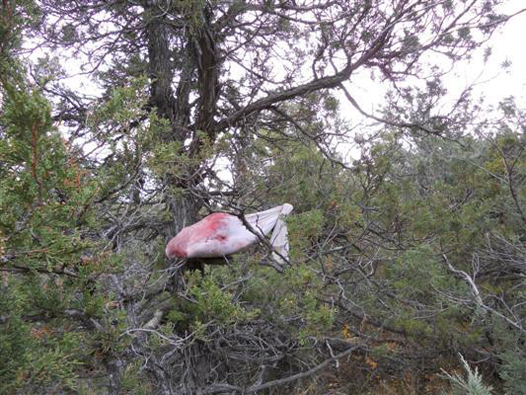
If you have to leave meat behind, find a place that will keep it cool and out of the hands of bears, insects, or other predators that may move in and steal your hard-earned trophy.
TacticsIf the animal is within your comfortable carrying distance, then you can probably get by with quartering your animal and leaving the meat on the bone. I used to quarter and pack all animals that I shot because I didn’t want to take the time in the field to de-bone it. Well…after packing a bunch of animals through the years, I finally said I had enough, and now I de-bone everything. De-boning an animal makes your pack weigh a lot less, makes it easier to fit multiple game bags full of meat in your pack, and it helps cool your meat down faster.
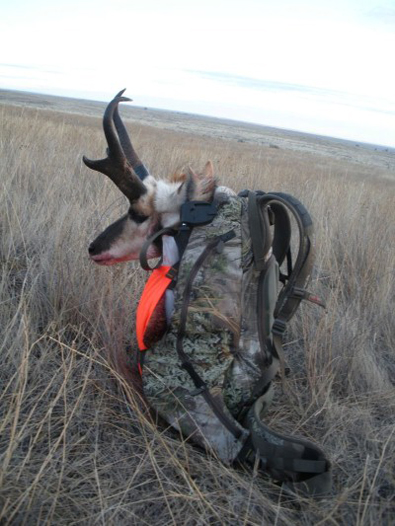
Small-framed animals such as antelope don’t necessarily require a complete “d-boning” process. Instead, many can be quartered and hauled back to the truck.
The Right Way To Pack ItI place my de-boned hindquarters in one game bag each and do the same for the front shoulders. All the rest of the meat (backstraps, tenderloins, neck, brisket, etc.) will get divided into the front shoulder bags. You will soon find out there is a proper way to pack meat out in a backpack and a way that will hurt your body. Place all your meat as close to your back as possible in your backpack, but keep it off the bottom of your pack for balance reasons. Nothing is more uncomfortable than having a heavy object strapped to the outside of your pack that will pull your body backwards or to the side. (choosing the right pack)
When I have gear with me on the first pack out, I will place all my extra clothes in the bottom of my pack with my sleeping bag. The rest of my gear (tent, food, etc.) will get distributed to the outside pockets to make room for the meat inside of the pack. If you’re concerned about getting a little blood on the inside of your pack then it will be useful to place your de-boned meat in a garbage bag. Some packs have load slings that enable the bag to move away from the frame, allowing the meat to be placed right next to your back, while still enabling your gear to be placed inside your backpack. I really love this design for comfort reasons and ease of carrying my gear out on the first trip.
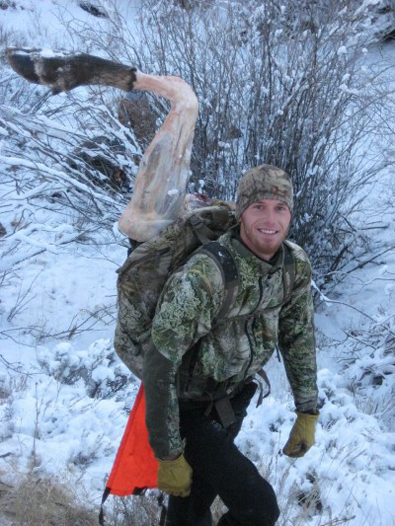
You may have a good backpack, but if it isn’t loaded correctly, the load will wear you down fast; possibly even injure you.
It is also very important that you utilize your compression straps on the outside of your pack. Nothing is more frustrating than hiking out with a heavy load of meat and a big buck rack on the outside of your back and having the rack bounce up and down or the meat falling around in the backpack. It will wear you out in a hurry…trust me on this one. Don’t ever try to stand and lift the pack up to your shoulders either. For one…it will hurt and two it has the potential to tear your shoulder straps by forcing all the weight to that one area. Instead, before I load the meat in my pack, I will place my pack near a spot that allows me to sit down on a bench and slip the shoulder straps on and get my waist belt buckled. Then I just need to lean forward and stand up. If that is not an option in the area you shot your animal, then I would suggest sitting down and getting your pack strapped on and do those same steps, but before you try to stand, roll onto your hands and knees facing uphill and then push yourself off the ground. Once standing, you will be able to adjust the shoulder straps, sternum strap, and waist belt. (backpack forum)
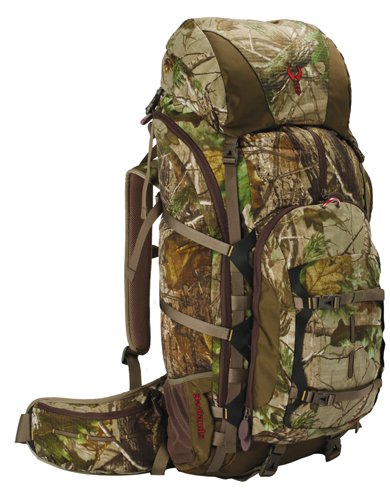
With a Polycarbonate Frame, AirTrack Suspension, and 4700 cubic inches in carrying capacity, the all-new Badlands Summit is designed to handle any load you can through at it.
The best advice I was ever given was don’t pack out what you are not going to use or consume. If I know I am not going to mount the buck, I will remove the entire hide from the skull and start to remove some of the meat from it as well. Also, I will remove the lower jaw because I have never found a need for it. I usually do a skull mount of most of my average bucks, but if you really want to lighten more of your pack out weight, then you can cut the skull plate in half below the antlers.
Backpack ConsiderationsHaving a pack that can handle the extra weight of meat plus gear is something to take into consideration before your hunt. You cannot place a heavy load in a pack that isn’t designed for that function. Lightweight packs may be great for ease of hunting, but most of the time they lack the comfort and adjustability of a do-it-all type pack. I am a huge fan of a pack that I can use for a week long hunt, and if I harvest an animal I can use that same pack to haul meat out. I am not easy on my backpacks- to me they are a tool to haul weight and haul it comfortably. So I will use my same pack for hunting as well as getting my hard earned protein to the table.
Another great option if you don’t want to get your nice backpack a little dirty or if it cannot handle the weight, is to have an external frame meat pack waiting for you at the truck. This way you could process your animal in the field, hang the meat in a shaded tree to cool, and then hike back to your vehicle to retrieve your meat hauling pack. It comes down to personal preferences and whether or not you’re willing to burn more miles going to get a different pack. Personally, I follow the “less trips mentality, so I chose a backpack that can do anything I ask of it.
Closing TipsI always keep my knife and tags in the same pocket on my pack. That way I have peace of mind knowing that I won’t lose them or dig through all my gear after I make a kill to find them. For attaching your tags to your trophy, keep it simple and use electrical tape. I always bring along a short section just for tags, since you don’t need a full roll of extra weight. If you shot anything larger than a deer such as an elk or a moose and you need to make multiple trips, make sure you place your meat high in a tree away from the reach of bears.
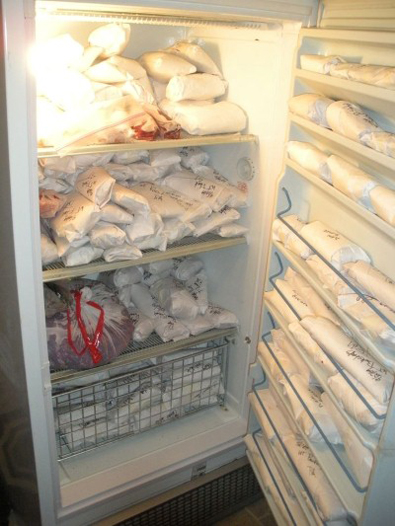
The end goal is memories on the wall, and a freezer full of healthy venison. Take the right approach and this will be an easily achievable goal.
Also for multiple trips, ensure your meat will be in the shade most of the time while you are packing the first few loads of meat and select a location with ample breeze to further cool the meat while you are away. Another great option for keeping your meat safe from insects or bacteria is using a mixture of citric acid powder and water. Citric acid will slow bacteria growth and prevent flies from trying to get through your game bag. This would be a great option for the solo hunter who is chasing elk deep in the backcountry. Finally, always be cautious while cutting up meat and returning to meat hanging in a tree in bear country….you never know what could be waiting when you return.











































